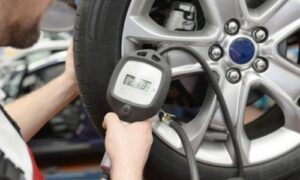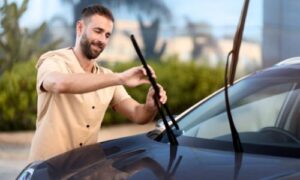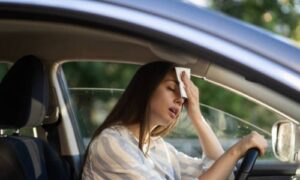Hydrophobic coating for car glass has gained significant popularity in recent years due to its ability to repel water and improve visibility during rainy conditions. These coatings work by creating a thin, protective layer on the glass surface that causes water to bead up and roll off, reducing the need for constant windshield wiper usage. However, with the growing market of hydrophobic coatings, it can be challenging for consumers to navigate through the various options available and choose the most effective one for their needs.
Introduction:
In the fast-paced world of automotive technology, innovations aimed at enhancing driving experiences continue to emerge. One such groundbreaking advancement is the application of hydrophobic coatings for car windows. These coatings are designed to revolutionize visibility, safety, and overall driving satisfaction. In this comprehensive blog post, we’ll delve into the intricate details of hydrophobic coatings for Car glass, exploring their benefits and applications.
Understanding Hydrophobic Coating for Car Windows:
Hydrophobic coatings for car windows are specially formulated to repel water and other liquids, creating a self-cleaning effect. These coatings use nanotechnology to create a thin, invisible layer on the glass surface that prevents water droplets from sticking and obscuring visibility. This technology not only improves driving safety during rainy conditions but also reduces the need for frequent window cleaning, saving time and effort for car owners. Additionally, hydrophobic coatings can enhance the overall aesthetics of a vehicle by giving the windows.
What is Hydrophobic Coating for Car?
Hydrophobic coatings are specially formulated solutions that repel water. When applied to auto glass, these coatings create a water-resistant surface, causing water droplets to bead up and roll off. The term “hydrophobic” literally means “afraid of water,” emphasizing the repellent nature of these coatings.
How Does Hydrophobic Coating for Car Work?
Hydrophobic coatings work on the principle of surface tension. By altering the surface properties of auto glass, these coatings reduce adhesion, making it difficult for water to spread out and form a continuous film—instead, water beads up, carrying away dirt, debris, and even some types of contaminants.
Benefits of Hydrophobic Coating for Car Windows:
There are several benefits of applying a hydrophobic coating to car windows. Firstly, it enhances visibility during rainy conditions as water droplets easily slide off the glass, reducing the need for constant windshield wiper usage. Additionally, these coatings also make it easier to clean the windows as dirt and grime are less likely to stick to the surface, resulting in a longer-lasting shine.
Improved Visibility in Rainy Conditions
One of the primary benefits of hydrophobic coatings is their ability to enhance visibility during rainy weather. The water-repellent surface ensures that rainwater beads up and slides off, preventing it from obstructing the driver’s view. This is particularly important in heavy rain or when driving at high speeds, as it allows for better reaction time and reduces the risk of accidents. Moreover, the hydrophobic coating also helps to minimize the formation of fog on the windshield, further improving visibility in adverse weather conditions.
Enhanced Safety
Clear visibility is crucial for safe driving. Hydrophobic coatings contribute to safer road experiences by minimizing the impact of adverse weather conditions on visibility. This is particularly valuable during heavy rainfall or snowfall. In these conditions, the hydrophobic coating on the windshield repels water and snow, preventing them from obstructing the driver’s view. Additionally, the improved visibility provided by hydrophobic coatings helps drivers to better anticipate and react to potential hazards on the road, reducing the likelihood of accidents.
Easy Cleaning and Maintenance
The water-repellent nature of hydrophobic coatings makes it easier to clean auto glass. Since water beads up and carries away dirt and contaminants, the need for frequent cleaning is significantly reduced. This not only saves time but also contributes to the longevity of the auto glass. In addition, the hydrophobic coatings also help to prevent the build-up of hard water stains and mineral deposits on the auto glass. This means that drivers can maintain a clear and pristine view through their windows for longer periods, further enhancing their safety on the road.
Application of Hydrophobic Coating for Car Windows:
The application of hydrophobic coating for car windows is a relatively simple process that can be done by professionals or even DIY enthusiasts. The coating is typically sprayed onto the glass surface and then evenly spread using a microfiber cloth. Once applied, it forms a protective barrier that repels water and other liquids, making it easier to clean and maintain the windows. This not only enhances the aesthetic appeal of the vehicle but also improves visibility during rainy conditions, ultimately ensuring a safer driving experience.
Professional Application vs. DIY Solutions
While there are DIY hydrophobic coating products available, professional application is recommended for optimal results. Professional technicians ensure even and thorough coverage, maximizing the effectiveness of the coating. DIY solutions may not provide the same level of durability and longevity. Additionally, professional applications often include a warranty or guarantee, giving peace of mind to the vehicle owner. This ensures that if any issues arise with the hydrophobic coating, they can be addressed and resolved by professionals.
Compatibility with Different Auto Glass Types
Hydrophobic coatings are generally compatible with various auto-glass types, including laminated and tempered glass. However, it’s crucial to consult with professionals to ensure compatibility and adherence to manufacturer recommendations. Using a hydrophobic coating on laminated or tempered glass can enhance the visibility and safety of the vehicle, as it repels water and improves driving conditions during rainy weather. It is important to follow the manufacturer’s recommendations to ensure proper application and longevity of the coating on different auto glass types.
How to Apply Hydrophobic Coating for Car
Applying a hydrophobic glass coating to your Car can significantly enhance visibility and ensure a sleek, well-maintained appearance. Now, we will walk through the process, emphasizing the importance of surface preparation and providing a step-by-step application method.
Preparing the Surface
Before diving into the application process, it’s crucial to prepare the Car’s glass surface adequately. Follow these steps for optimal results:
1. Thorough Washing
Start by washing your Car’s windscreen thoroughly. Use a high-quality automotive shampoo to remove dirt and grime. Make sure to pay extra attention to the edges and corners of the glass. Rinse off any soap residue with clean water and dry the surface completely using a microfiber cloth. This will ensure a clean base for the application of the glass coating. Ensure that all contaminants are washed away to create a clean surface for the layer.
2. Clay Bar Treatment
Consider claying your windscreen to remove any surface contaminants that might persist after washing. Claying your windscreen will help eliminate stubborn dirt, road grime, and even tiny particles that may be stuck on the surface. This step will ensure a smooth and pristine surface, allowing the glass coating to adhere properly and provide optimal protection. A clay bar, such as Gtechniq G4, can effectively lift embedded particles, providing a smooth surface for the coating to adhere to.
3. Glass Polish (if necessary)
If your glass still doesn’t appear in perfect condition after washing and claying, use a glass polish like Gtechniq G4 to address any remaining imperfections. Glass polish is specifically designed to remove stubborn stains, water spots, and light scratches from the glass surface. It will help restore clarity and enhance the overall appearance of the glass before applying the coating. Make sure to follow the manufacturer’s instructions for proper application and use a microfiber cloth for best results. This step ensures an impeccably clean surface for the coating.
Application of Hydrophobic Coatings for Car
Now that the surface is properly prepped, it’s time to apply the glass coating. Follow these steps for a successful application:
1. Gather Materials
Most glass coatings come with an applicator and an applicator cloth. If your chosen glass coating does not include these items, make sure to gather a lint-free cloth and a foam applicator pad. These materials will help ensure an even and smooth application of the coating onto the glass surface. Ensure you have these on hand before starting the application process.
2. Apply Coating with Applicator Pad
Using the applicator pad, apply the glass coating to the windscreen from the driver’s side to the passenger side. Be sure to apply the coating in a consistent and even manner, using gentle and overlapping strokes. This will help to ensure that the entire surface is properly coated for maximum effectiveness and protection. Ensure even coverage, and don’t worry about removing the residue just yet.
3. Repeat application
Without removing the residue, repeat the application from the driver’s side to the passenger side for a second coat. This second coat will further enhance the effectiveness and durability of the coating, providing an extra layer of protection for your windscreen. Remember to maintain the same consistent and even application technique to ensure uniform coverage across the entire surface. This double application enhances the effectiveness of the coating.
4. Apply to Side and Rear Screens
Continue applying the product to the side and rear screens. Afterward, go back to your windscreen for a third coat. Using the coating on the side and rear screens ensures that all areas of your vehicle’s glass surfaces are protected. The third coat on the windscreen further enhances its durability and effectiveness, providing maximum protection against environmental elements. Working in overlapping motions ensures complete coverage without missing any spots.
5. Buff Off Excess
Glass coatings typically bond quickly. Under normal temperatures, they should cure within a minute or two. Once the coating has cured, use a clean microfiber cloth to buff off any excess residue gently. This will leave your glass surfaces with a smooth and clear finish, ready to repel water, dirt, and other contaminants. Use a clean microfiber cloth to buff off the excess residue, revealing a crystal-clear finish.
Bonus Tip: Wiper Blade ApplicationFor an extra touch, apply a small amount of the glass coating to your Car’s wiper blades. This enhances their repelling ability, contributing to improved visibility during rainy conditions.
Congratulations! You have successfully applied a hydrophobic glass coating to your Car, unlocking the benefits of enhanced visibility and a sleek appearance. Enjoy the clarity and repelling power of your newly coated car glass.
FAQs about Hydrophobic coatings for Car
Q. Can Hydrophobic Coatings Be Applied to Windshields with Existing Chips or Cracks?
In most cases, hydrophobic coatings are applied to structurally sound auto glass. If your windshield has existing chips or cracks, it is advisable to repair or replace the glass before applying the coating. The coating may not adhere properly to damaged glass, compromising its effectiveness.
Q. How Long Does Hydrophobic Coating Last?
The durability of hydrophobic coatings varies depending on factors such as the quality of the coating, environmental conditions, and driving habits. On average, a professionally applied hydrophobic coating can last anywhere from six months to two years. Regular maintenance and reapplication may be necessary to ensure continued effectiveness.
Q. Is Hydrophobic Coating Environmentally Friendly?
Many hydrophobic coatings are formulated to be environmentally friendly, with water-based solutions and low volatile organic compound (VOC) content. However, it’s essential to check the product specifications and choose coatings that align with eco-friendly practices.
Q. Can Hydrophobic Coatings Be Applied to Side Mirrors and Rear Windows?
Yes, hydrophobic coatings can be applied to side mirrors and rear windows to provide the same benefits of improved visibility and easier maintenance. Ensuring comprehensive coverage enhances the overall driving experience.
Conclusion:
In conclusion, hydrophobic coatings for auto glass represent a transformative advancement in automotive technology. By embracing these coatings, drivers can enjoy improved visibility, enhanced safety, and easier maintenance. Whether navigating through heavy rain or dealing with everyday dirt and debris, the hydrophobic coating for car windows is a valuable investment that contributes to a clearer and safer driving experience. As technology continues to evolve, so too will the possibilities for enhancing our journeys on the road. With the continuous advancements in auto glass technology, we can expect even more innovative features to be integrated into our vehicles. From self-cleaning capabilities to smart sensors that detect and repel objects, the future of auto glass holds immense potential for revolutionizing our driving experiences.






